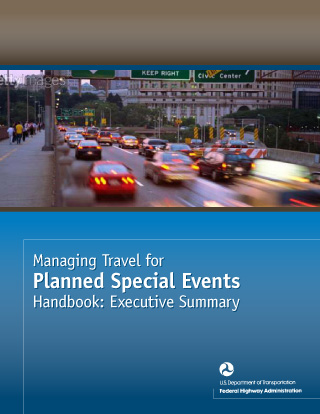Managing Travel for Planned Special Events Handbook: Executive Summary

June 2007
FHWA-HOP-07-108

Federal Highway Administration
U.S. Department of Transportation
1200 New Jersey Avenue, SE
Washington, DC 20590
Toll-Free "Help Line" 866-367-7487
www.ops.fhwa.dot.gov
Printable Version [PDF 1.7MB]
To view PDF files, you need the Adobe Reader.
Contact Information: Operations Feedback at OperationsFeedback@dot.gov.
Table of Contents
Event Impacts and Stakeholders
Regional Planning and Coordination
Planning, Implementing, Operating, and Evaluating
Technical Report Documentation Page
List of Tables
Table 1-1: Reasons to Manage Travel for Planned Special Events
Table 1-2: Stakeholder Challenges and Goals
Table 1-3: Sample Annualized Economic Impact
Table 1-5: Decision Maker's Role Relative to Chapter One Material
Table 1-6: Decision Maker's Responsibility to Community
Table 2-1: Categories of Planned Special Events
Table 2-2: Considerations in Managing Travel for a Discrete/Recurring Event at a Permanent Venue
Table 2-3: Considerations in Managing Travel for a Continuous Event
Table 2-4: Considerations in Managing Travel for a Street Use Event
Table 2-5: Considerations in Managing Travel for a Rural Event
Table 2-6: Decision Maker's Role in Planned Special Events Categories
Table 2-7: Decision Maker's Responsibility to Community
Table 2-8: Decision Maker's Role in Planned Special Events Phases
Table 2-9: Decision Maker's Responsibility to Community
Table 2-10: Decision Maker's Role in Fulfilling Purposes
Table 2-11: Decision Maker's Responsibility to Community
Table 2-12: Decision Maker's Role in Managing the Planning Schedule
Table 2-13: Decision Maker's Responsibility to Community
Table 3-1: Decision Maker's Role in Event Impact Issues
Table 3-2: Decision Maker's Responsibility to Community
Table 3-3: Decision Maker's Role in Relation to Stakeholders
Table 3-4: Decision Maker's Responsibility to Community
Table 3-5: Decision Maker's Role in Successful Stakeholder Coordination
Table 3-6: Decision Maker's Responsibility to Community
Table 3-7: Groups Requiring Special Accommodations
Table 3-8: Decision Maker's Role in Travel Choices
Table 3-9: Decision Maker's Responsibility to Community
Table 4-1: Decision Maker's Role in Regional Planning and Coordination
Table 4-2: Decision Maker's Responsibility to Community
Table 4-3: Regional Initiative and Activity Focus Areas
Table 4-4: Decision Maker's Role in Regional Initiatives and Activities
Table 4-5: Decision Maker's Responsibility to Community
Table 4-6: Cost Management Program for Planned Special Events
Table 4-7: Planned Special Event Funding Mechanisms
Table 4-8: Louisville, KY Criteria for Providing Free Services for a Special Event
Table 4-9: Decision Maker's Role in Funding
Table 4-10: Decision Maker's Responsibility to Community
Table 5-1: Traffic Management Plan Components
Table 5-2: Decision Maker's Role in Event Operations Planning
Table 5-3: Decision Maker's Responsibility to Community
Table 5-4: Decision Maker's Role in Implementation Activities
Table 5-5: Decision Maker's Responsibility to Community
Table 5-6: Decision Maker's Role in Day-of-Event Activities
Table 5-7: Decision Maker's Responsibility to Community
Table 5-8: Event Management MOE (Measures of Effectiveness)
Table 5-9: Decision Maker's Role in Post-Event Activities
Table 5-10: Decision Maker's Responsibility to Community
Table 6-1: Purposes for Planned Special Events
Table 6-2: Decision Maker's Role in Managing Travel for Planned Special Events
Table 6-3: Decision Maker's Responsibility to the Community
List of Figures
Figure 1-1: City of Chicago Website
Figure 2-1: Event Operations Planning Schedule
Figure 3-1: Planned Special Event Factors
Figure 3-2: Planned Special Event Stakeholders
Figure 3-3: Planned Special Event Activity Networks
Figure 5-1: Traffic Flow Route Planning Map
Figure 5-2: Traffic Management Team Command Centers